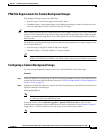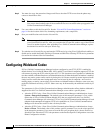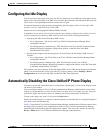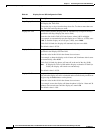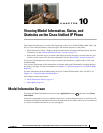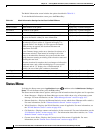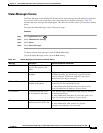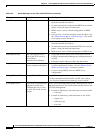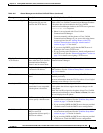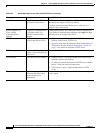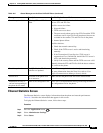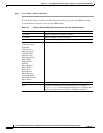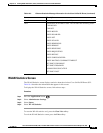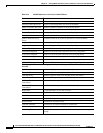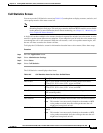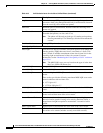
10-5
Cisco Unified IP Phone 8961, 9951, and 9971 Administration Guide for Cisco Unified Communications Manager 8.5 (SIP)
OL-20861-01
Chapter 10 Viewing Model Information, Status, and Statistics on the Cisco Unified IP Phone
Status Menu
File not found <Cfg File> The name-based and default
configuration file was not
found on the TFTP Server.
The configuration file for a phone is created when the phone is
added to the Cisco Unified Communications Manager database.
If the phone has not been added to the Cisco Unified
Communications Manager database, the TFTP server generates
a
CFG File Not Found response.
• Phone is not registered with Cisco Unified
Communications Manager.
You must manually add the phone to Cisco Unified
Communications Manager if you are not allowing phones
to auto-register. See the “Adding Phones with Cisco
Unified Communications Manager Administration”
section on page 2-12 for details.
• If you are using DHCP, verify that the DHCP server is
pointing to the correct TFTP server.
• If you are using static IP addresses, check configuration of
the TFTP server. See the “Ethernet Setup Menu” section on
page 7-4 for details on assigning a TFTP server.
File Not Found
<CTLFile.tlv>
This message displays on the
phone when the Cisco Unified
Communications Manager
cluster is not in secure mode.
No impact; the phone can still register to Cisco Unified
Communications Manager.
IP address released The phone has been configured
to release its IP address.
The phone remains idle until it is power cycled or you reset the
DHCP address. See the “Ethernet Setup Menu” section on
page 7-4 for details.
ITL installed The ITL file is installed in the
phone.
None. This message is informational only. The ITL file was not
installed previously.
For more information about the ITL file, refer to Cisco Unified
Communications Manager Security Guide.
Load rejected HC The application that was
downloaded is not compatible
with the phone’s hardware.
Occurs if you were attempting to install a version of software
on this phone that did not support hardware changes on this
newer phone.
Check the load ID assigned to the phone (from Cisco Unified
Communications Manager, choose Device > Phone). Re-enter
the load displayed on the phone.
No default router DHCP or static configuration
did not specify a default router.
• If the phone has a static IP address, verify that the default
router has been configured. See the “Ethernet Setup Menu”
section on page 7-4 section for details.
• If you are using DHCP, the DHCP server has not provided
a default router. Check the DHCP server configuration.
No DNS server IP A name was specified but
DHCP or static IP
configuration did not specify a
DNS server address.
• If the phone has a static IP address, verify that the DNS
server has been configured. See the “Ethernet Setup Menu”
section on page 7-4 section for details.
• If you are using DHCP, the DHCP server has not provided
a DNS server. Check the DHCP server configuration.
Table 10-2 Status Messages on the Cisco Unified IP Phone (continued)
Message Description Possible Explanation and Action



